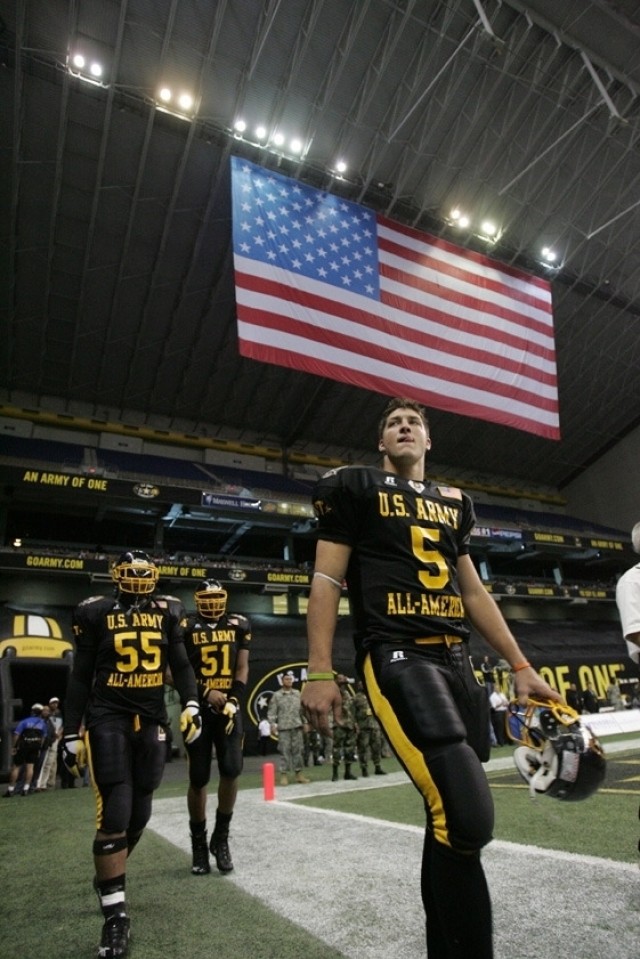WASHINGTON (Army News service, Dec. 6, 2006) - Some 80 high school football players across the country have been selected to participate in one of the Army's highest-profile public-relations events, the U.S. Army All-American Bowl.
The game, to be played Jan. 6 in San Antonio, Texas, is the feature event in a series of outreach activities designed to support Army recruiting efforts.
"This initiative helps the command and the Army maintain their connections with America," said Tom Tiernan, outreach and event marketing chief at U.S. Army Accessions Command.
This year the event drew a crowd of more than 31,000, the largest since the first All-American Bowl in 2002. And with a national television audience the event, intended to help develop leads for recruiters and referrals for Cadet Command, will reach millions of educators, coaches, parents and others who play powerful roles in the lives of young people.
The All-American Bowl opens doors for discussion between recruiters and high school football coaches about what the Army can do for the football players, said Tiernan.
Many football players don't get scholarships and need other opportunities in order to be successful in life, Tiernan said. The All-American Bowl gives recruiters the chance to educate coaches on opportunities available in the Army.
Though the connection between football and the Army may not be an obvious one, sports, like football, actually instill values that are a hallmark of today's Army.
Tiernan compared the players on a football team with an Army squad.
"It's the same as in the Army where a squad comes together and the individuals bring their own skills and talents," Tiernan said. Under the proper leadership, they become a cohesive team, more powerful than any one individual.
Recruiters distributed 400 player nominations made by football-player recruiters in August, and a selection tour began in September.
Besides on-the-field skills, U.S. Army All-Americans must be high school seniors, eligible to graduate in the spring of the year in which they participate, and in good standing in their schools and communities.
A player in the 2006 bowl, Micah Johnson is a case in point.
Being selected for the bowl was especially meaningful to this linebacker. His father, Lt. Col. Skip Johnson, deployed to Iraq in September 2005. He missed his son's senior season, including the bowl game.
"Even though I wasn't there, I watched part of the game and was there in spirit," the elder Johnson said. He was able to connect with his son through a segment on ESPN, via satellite.
"It was real cool to play in the All-American Bowl," the younger Johnson said. "I had wanted to play in it because I would be representing the Soldiers and my country."
As a senior at Fort Campbell, Ky., Johnson was one of the nation's top football prospects. He earned his state's "Mr. Football" honor after playing just two years for the school team.
Johnson considered playing college football at Georgia State and the University of Notre Dame, but ultimately chose the University of Kentucky, where his brother, Christian, already was a member of the football team.
Johnson said the environment at the bowl was "intense."
"The atmosphere in San Antonio is big," he said. "All week we got tons of fan support."
Many of the activities included in previous All-American Bowl programs will return in 2007. During pre-game activities last year, veterans of Operations Iraqi Freedom and Enduring Freedom were introduced to the crowd, and Fort Sam Houston Advanced Individual Training Soldiers recited the Soldier's Creed.
Army Vice Chief of Staff Gen. Richard A. Cody enlisted some 100 new recruits, while Gen. William Wallace, the commanding general of Training and Doctrine Command, commissioned two ROTC graduates.
The U.S. Army Field Band participated, and 101st Airborne Division Soldiers rappelled from the Alamodome's rafters to present the game ball to the players.
"The value of bringing these folks from the Army is that it's an opportunity to showcase the Army," said Tiernan.
Leads for potential new recruits are also generated at All-American Bowl-related events, such as a breakfast, awards dinner, cheerleading clinic and what's called the Fan Fiesta.
A band competition held in previous years will also be replaced in 2008 with the U.S. Army All-American Band, with participants selected from each of the 50 states. The change will allow recruiters to reach out to another group of high school students and their parents, Tiernan said.
(Mary Kate Chambers writes for the U.S. Army Recruiting Command.)


Social Sharing